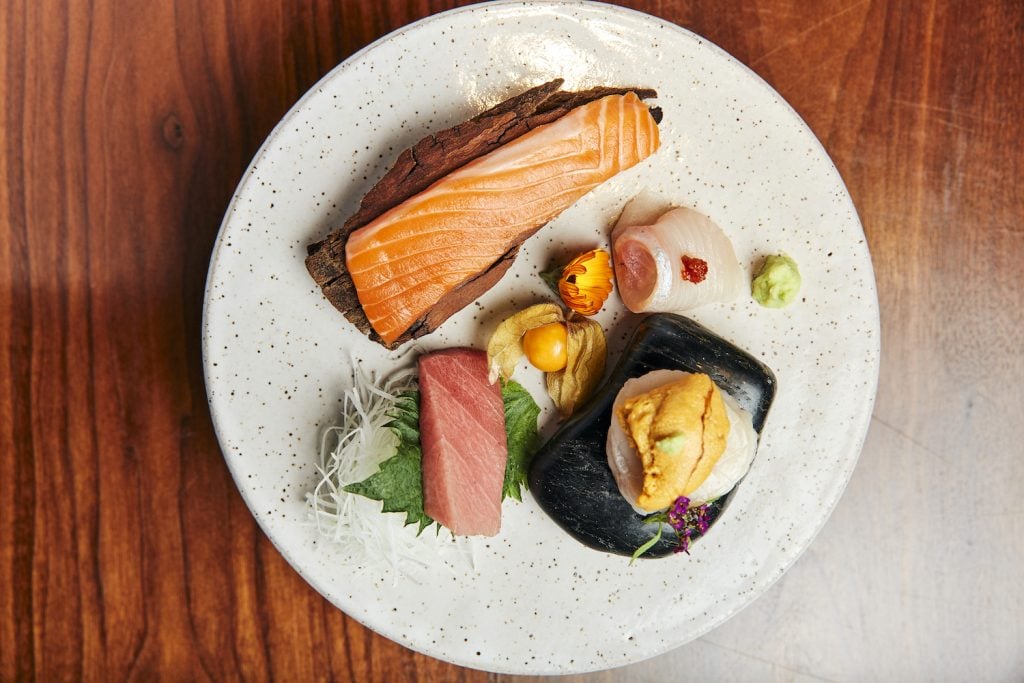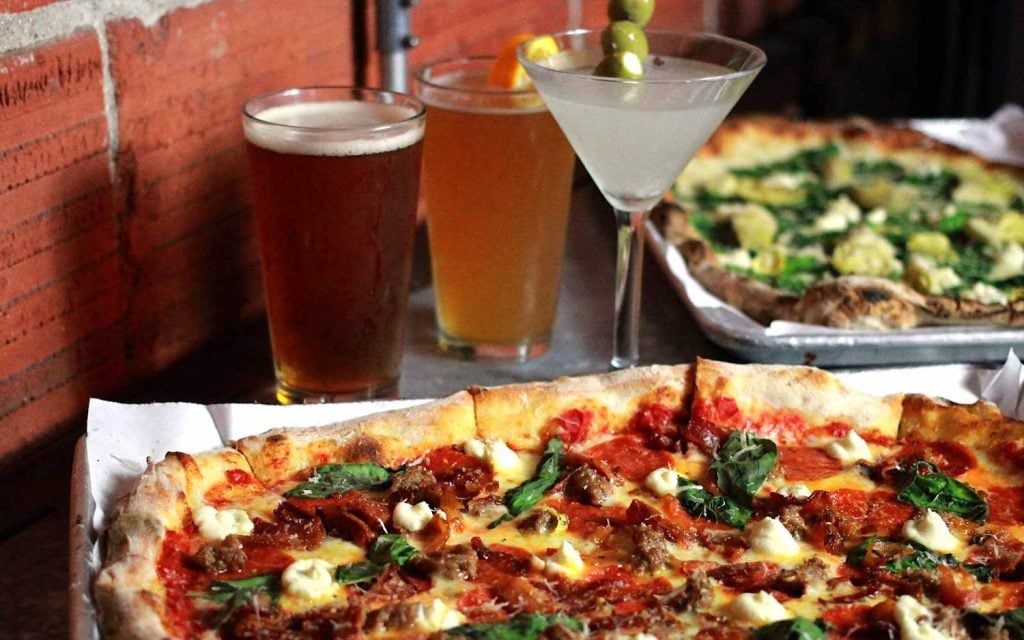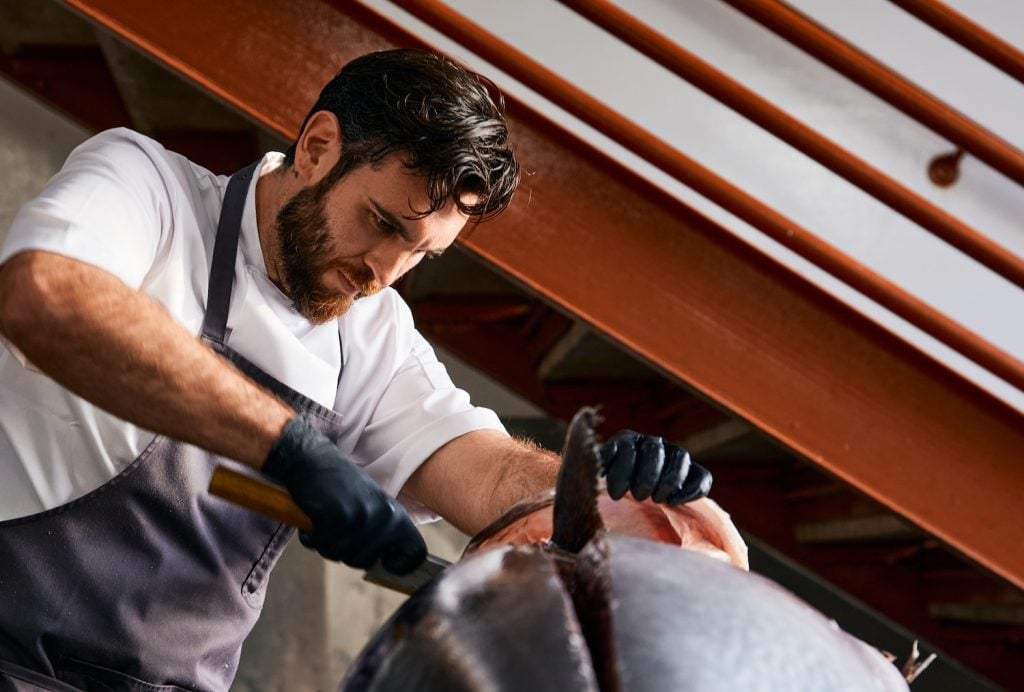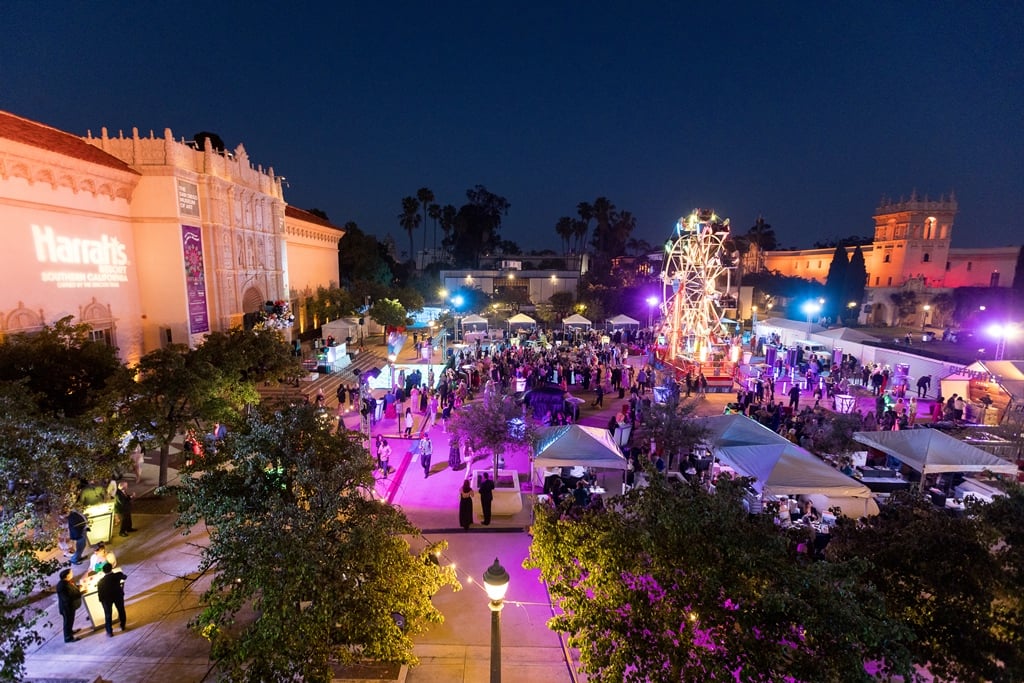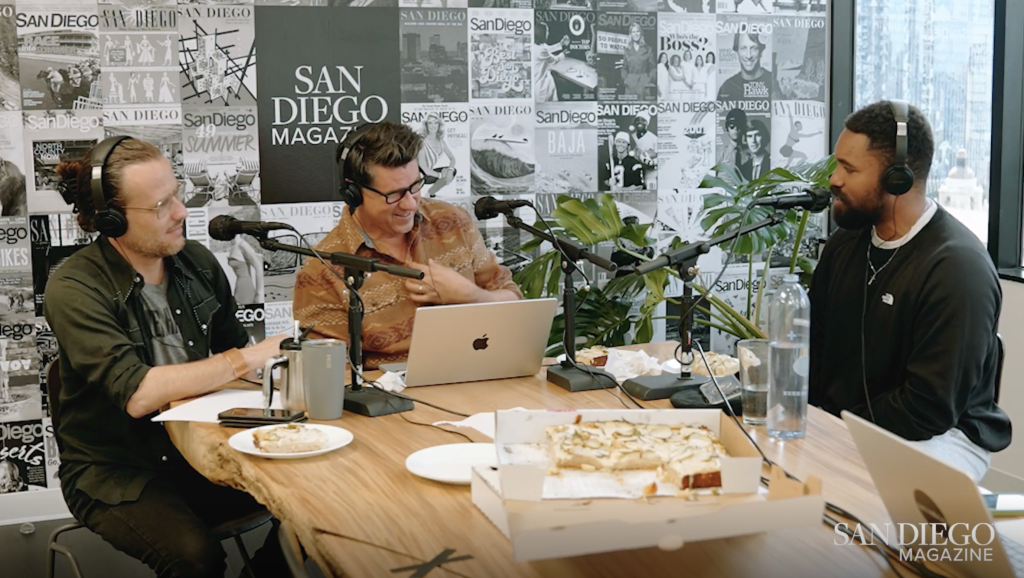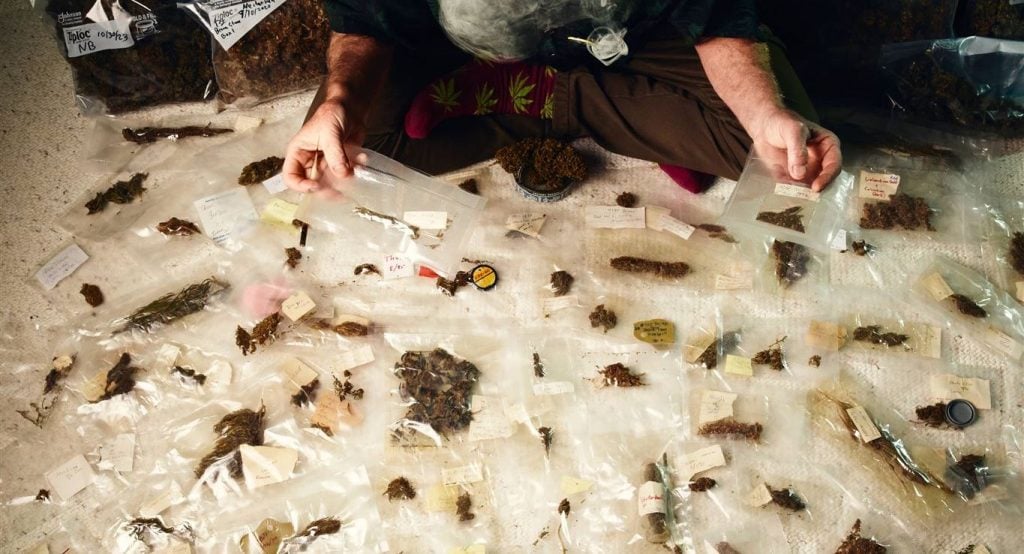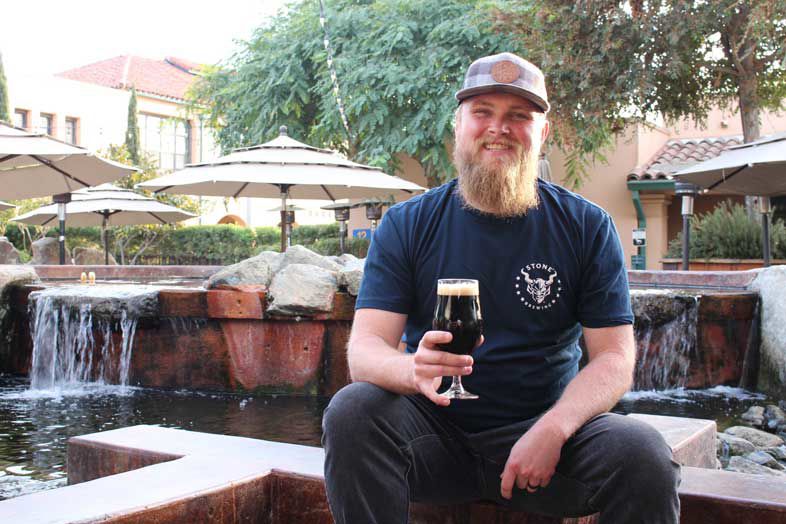Here’s the biggest compliment you could pay Stone brewer Kris Ketcham: If you close your eyes and taste one of his beers, you’ll likely think it comes from a smaller brewery. For all intents and purposes, it does—just one within a large brewing company.
The coolest thing about Kris’s Liberty Station setup is that Stone has basically given him the resources and the freedom to brew like an independent, small-scale brewer, but without all the financial worries and headaches that go along with it. Kudos to Stone for doing this, and doing it well. It’s great to see a large company keep its hands off in the right places; it’s not easy. In return, they’ve gotten a de facto R&D brewery facility that produces consistently interesting, creative, high-quality beer that delights Stone fans and greatly enhances the company’s overall portfolio.
I sat down with Kris by a waterfall koi pond in the beer garden at Liberty Station to talk about brewing at this unique outpost. As we chatted, I couldn’t help but ask for tastes of the many intriguing brews available on the menu, including Jilted Kiwi Saison (a perfect balance of flavors, with kiwi, basil, and coriander), Seven Letters Golden Ale (light, crisp, and delicately flavored with lemongrass and sake yeast) and the mind-boggling but totally delicious Tartistry kettle sour made with peanut butter and strawberry (Yes! It actually works!).
When did you start with Stone?
It’ll be 14 years in less than a month. It was December 27, 2004.
How did you start in Escondido? Assistant brewer? Keg washer?
Nope. I started on the bottling line. I was a huge fan of Arrogant Bastard and I had some friends of a friend who worked at Stone at the time. I also heard that you’d get free beer working there. I remember thinking to myself, “Wait. You mean you get a job PLUS free beer?” So I was all in. I did that for about a year and a half. Then I wanted to branch out, see more about where the beer goes, so I took a job in distribution. I was a delivery driver for all of North County for about a year and a half, but while doing that, I ran into my high school math teacher, Mark Purciel, who had a brewery called Oceanside Ale Works at the time. I remembered him being a really awesome math teacher. I went to visit him at his brewery one day and he was getting ready to brew, so I asked him if I could just hang out and watch. I had never brewed beer and I wanted to see how it was done. He said sure, and I got hooked immediately.
What’s the most significant thing you’d say you learned from Mark at Oceanside Ale Works?
It’s the same for everybody: cleaning. It’s always the cleaning, man! It was the cleaning, but I also learned how to have fun while brewing. That’s important.
Would you say that learning the proper sanitation techniques is more difficult than learning the actual brewing procedures?
It’s all actually about being disciplined. I don’t think cleaning is difficult, but once you start getting lazy about it, you can start to make mistakes that will screw up everything else you’re doing.
Okay, so you’re driving around delivering beer for Stone while also learning to brew at Oceanside Ale Works. At what point did that become a brewing job at Stone?
Well, that’s kind of a funny story. Oceanside Ale Works had someone in there taking a photo and they caught me brewing in the photo, mashing in grains. A little while later, Greg [Koch, Stone cofounder] called me into his office. He was like, “Hey. So I was reading the paper this morning… You want to tell me about something?” And I didn’t know what he was talking about. Then he showed me. I was right there on the front page! Brewing beer at Oceanside. I got really nervous and asked him if it was a conflict of interest or a problem and he said no, Stone encouraged that kind of thing. But then he said if I wanted to brew, I should just talk to Mitch [Steele, former head brewer]. He said Stone would love to have me on the brewing side. Soon after, I brought a brown ale I had brewed at Oceanside in to Mitch and he said the beer was awesome and he had no idea I liked brewing. Then he told me they were hiring an assistant brewer. That sounded great, but the problem was, I was already brewing at Oceanside, which I loved, and I was told I couldn’t work on the brewing side at both places.
So you took the Stone brewing job?
I actually didn’t! I was content being a driver and working at Oceanside. Then I developed this condition. It sounds weird, but delivering kegs is probably one of the hardest brewery jobs there is. You’re constantly on the road, dealing with traffic, and you’re physically getting in and out of your truck, lifting kegs, and putting them in weird places. Somehow, with all the heavy lifting, my muscle grew into a bone in my knee and I had this weird bone contusion. My bone was actually snapping on my muscle. I thought I had torn something in my knee. It got so painful that, any time I lifted a keg, it was just pain. So I had to stop delivering, and the option was either stop doing that altogether or have the bone shaved down, which is kind of risky. It just so happened that Stone was hiring for a packaging supervisor at the time, which was my previous background, so that was a nice, smooth transition.
So, packaging supervisor was the next step.
I shared an office with Mitch for about two years and he got to know me and kind of liked my style. When they needed a new cellar supervisor, Mitch asked me, even though I had absolutely no experience with that. But he trusted me and knew the way I worked, and offered to teach me what I’d need to know. So I did bottling line supervisor for about two years and then cellar supervisor for about two years as well. Then the Liberty Station brewer gig opened up, and that’s when I applied for it and got it.
Tell me about how the Liberty Station gig was initially described to you. The idea was to have a small-batch, R&D-type system, right?
When Liberty Station first came about, it was the only hub we had for R&D brewing at the time. Before that, all of our R&D beers were done on an 18-gallon pilot system. When the new position was presented, it was “Liberty Station Brewing Manager,” which was a lot of R&D but also about controlling everything from grain to glass—all the ingredients, et cetera. So I came in and immediately started going after new things and trying out a bunch of recipes.
I treat everything in this brewery as if it’s my own. I don’t like to spend a lot of money on things, and if something’s not working right, I’ll fix it myself.
Sounds like a great opportunity. They really did have a leap of faith, though, wouldn’t you say?
Yeah! I was very scared. I felt confident, but still aware that it was a high-profile brewing position. I didn’t want to be the guy who brewed for Stone’s first brewpub where the beers were just awful!
I just assumed that you were brewing for a certain number of years in Escondido and they moved you down here from there as a brewer. In some ways, I think it was a smart decision, in that you weren’t steeped in all the previous stuff. I mean, this was supposed to be different from Escondido—on a different track.
But it’s also got to live up to the quality. And they wouldn’t have given this position to just anyone. It had to be someone they knew they could trust. I treat everything in this brewery as if it’s my own. I don’t like to spend a lot of money on things, and if something’s not working right, I’ll fix it myself.
Were you given a mandate to come up with R&D recipes that could potentially become full-on production recipes?
When we first opened, it was a lot of recipes that Mitch had in line—things we’d been needing to brew for a while to get ourselves up to the next level.
More experimental things?
More experimental and also using new ingredients, like new hops. We had been wanting to have a single-hop series for a long time, but weren’t able to squeeze it in at the main brewhouse. We did a whole bunch of single-hop trials here. There were also a lot of events and charities we wanted to brew for, but we never could squeeze that in either. Stuff where we’d only need 15 kegs or so. All those got pushed onto me. Then there were all the collaboration beers we wanted to do with folks coming into town. So this became the recurring theme down here, doing collaborations and fun stuff. And if it worked out really well, we’d take it to a large scale.
Do you ever feel constrained at all to stay within the “Stone identity” with your beers? The one thing I’ve always thought was cool about the beers you do here is that they almost feel like they come from a totally different brewing company.
When we first started down here, I was all about brown ales and witbiers, which have always been my thing. And I know a few people up above aren’t big fans of brown ales—they think they’re boring, which is fine, but it’s always been a style of beer I like to make; we’ve always had this mentality that you should brew the beers you like to make but stay within the company’s quality expectations.
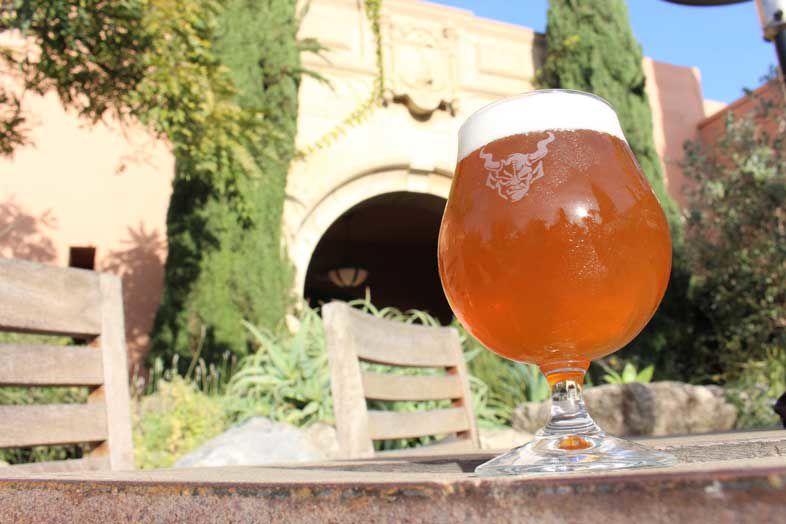
Have a Beer with Stone Liberty Station’s Head Brewer, Kris Ketcham
The beer menu at Liberty Station features a wide variety of styles that utilize lots of unique ingredients | Photo: Nathan Glassman-Hughes
Stone has never been witbier heavy!
No! And for me, when I got the job, I was told I could brew my styles of beers, meaning browns and witbiers, but I’d have to change them. I couldn’t just do them in a traditional style. They had to have a Stone spin on them. I said I want to brew a witbier and—I think it was the fifth I brewed here—I brewed Witty Moron, a black witbier. The first one had some challenges—it had kind of an ashy character to it—and some people said, “Please don’t brew that beer again.” But I was convinced I was onto something and could do it right. So I kept doing small tweaks and eventually it hit. People loved it and it caught on.
Witty Moron is a memorable triumph for you. Are there other beers you’re particularly gratified by having done?
Delicious IPA. That was Mitch’s baby from the start. I think we made three different versions. Greg came to Mitch and said he had an idea for a new beer: It’s called Delicious IPA. Create that beer.
That was it?
Yup! Greg said, whatever it is, the beer just has to be delicious. That was it. It was the same sort of feedback we got when we first developed Enjoy By. So Mitch gave me three different renditions for Delicious IPA, and they were all great. That was around the time we were experimenting with a bunch of new hops, and we wanted to develop the single-hop beers. We made a beer called Lost City of Liquid Gold, which was our single-hop El Dorado. I remember I had Mitch down for a brew day and said, “Hey, you should try this beer off the fermenter. This came out killer. It’s exceptional. It shows everything of the hop.” He pulled it off the fermenter, took a sip, and said, “Oh! That’s delicious!” And I was like, “DELICIOUS!” So we knew we had to incorporate that hop in that beer.
You’ve recently done a Brüt IPA, right?
Yup. We got one going that we just released: Enjoy By Brüt IPA for the new year. Then we also brewed with Julian from Beachwood a few weeks ago; we did a collaboration that was Brüt IPA as well. We’ve done a few kettle sours. I’ve been working more toward the imperial kettle sours lately. Tartistry, our peanut-butter-and-jelly Berliner weiss, is really awesome. It came about one day when I was trying to fix one of the kettle sours I had done. The fruit base wasn’t right. I always have peanut butter on my desk, as a quick snack food with good protein, and I asked one of our bartenders, Kenny, what he thought of the kettle sour samples I had. Kenny said, “Why don’t you just put peanut butter in it!” He was kind of joking, so I said, “Wow, you idiot, what a great suggestion!” Just to complete the joke, I actually put some peanut butter in a sample and tasted it. And it was really good! We’ve done a few of these now, one with strawberry as a base and two others, with blueberry and with raspberry.
Wow. So what could there possibly be left to do? I mean, you’re kind of like a kid in a candy store, right? You have the resources of Stone and the freedom to do pretty much what you want. That’s a pretty cool place to be.
Yeah. And I love to drink beer, but I guess I would say I’m still looking to create beers I can drink all day long. That’s why I’ve been really focused on really low ABV options, especially with hop-forward beers. When I was in Berlin, I had this beer from Fraü Gruber, a 2.8 percent hoppy pale ale. Anytime I see something like that, I want to try it and see if it’s good. Now I’ve been brewing for a long time, and this beer blew my frickin’ mind. It had the body, but you could taste no residual sugar, it was very light-bodied and had great head retention, which low-ABV beers usually don’t. This beer just drank like an Orange Julius. And the aromatics were insane. I thought to myself, “I want this so much.”
Did you ever find out what their technique is?
Nope. But I’m still playing around with it. I’ve got one version. It’s good, but it’s not what I want. So I’ll keep working on it until I get it!
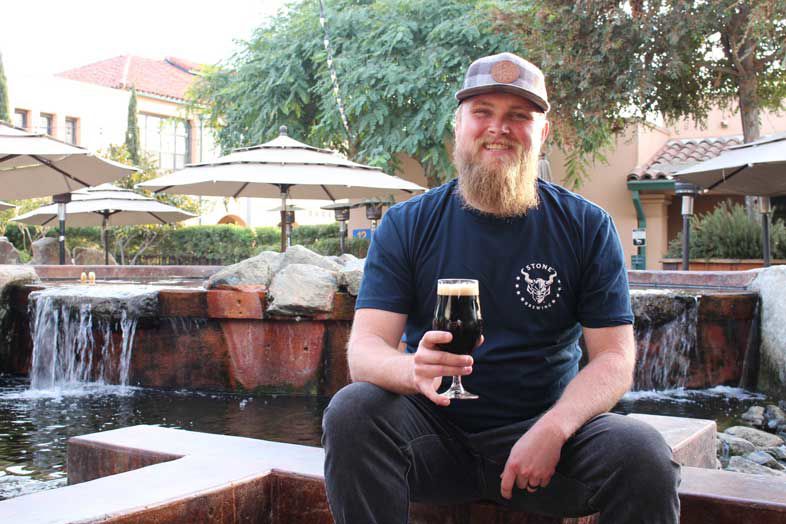
Have a Beer with Stone Liberty Station’s Head Brewer, Kris Ketcham
Kris Ketcham heads up the small-batch brewing program at Stone Liberty Station | Photo: Bruce Glassman
